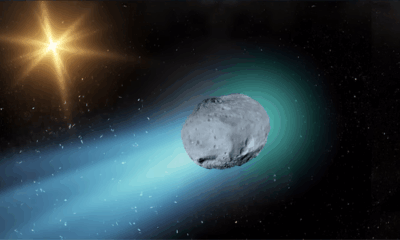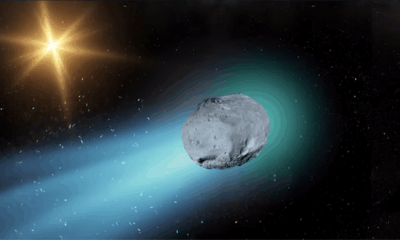Science
Alien Technology May Propel Interstellar Object 3I/ATLAS Towards Earth

Avi Loeb, a renowned astrophysicist from Harvard University, has put forth a provocative theory suggesting that the interstellar object known as 3I/ATLAS could be experiencing “non-gravitational acceleration” due to alien technology. According to Loeb, this phenomenon may indicate that the object is being manipulated by an advanced extraterrestrial engine, which he claims could be responsible for its unusual trajectory and characteristics.
Loeb’s assertions stem from observations of 3I/ATLAS, which reportedly exhibited a striking blue appearance as it approached the sun. This color change is particularly intriguing given that natural comets typically appear redder due to the scattering of sunlight by dust. He stated, “There was some propulsion that moved it away from its original trajectory, and I would have expected it would lose 10 to 20% of its mass as a result of the recoil.”
Unusual Characteristics of 3I/ATLAS
The designation “3I” indicates that this is the third known interstellar object catalogued by the Minor Planet Center, while “ATLAS” refers to the Asteroid Terrestrial-impact Last Alert System, the astronomical survey responsible for its detection. Loeb elaborates in his Medium post that the blue hue observed might be linked to either a technological signature from an onboard engine or a source of artificial light. He also mentioned the possibility of ionized carbon monoxide contributing to this visual anomaly.
Loeb’s observations highlight the ninth unexpected property of 3I/ATLAS, which continues to intrigue scientists. He emphasizes that the blue appearance contradicts typical expectations, as a natural comet’s surface should be around 20 times colder than the sun’s photosphere, which measures approximately 5,800 degrees Kelvin. Consequently, he argues that such a color shift at perihelion raises questions about the object’s nature.
Upcoming Close Approach to Earth
3I/ATLAS is projected to make its closest approach to Earth on December 19, 2024, when it will pass at a distance of approximately 167 million miles. This event presents a unique opportunity for scientists to study the object closely, potentially providing insights into whether it is a natural comet or something of artificial origin.
As the object continues on its trajectory out of the solar system, researchers are gearing up for what could be a defining moment in our understanding of interstellar objects. Further observations may clarify the mysteries surrounding 3I/ATLAS and its anomalous properties, possibly reshaping our perspectives on extraterrestrial life and technology.
The scientific community remains eager to gather data during this close flyby, which could yield significant findings about the composition and behavior of interstellar objects. As we approach the date, excitement builds around the potential revelations that may emerge from this enigmatic visitor from beyond our solar system.
-

 Entertainment2 months ago
Entertainment2 months agoAnn Ming Reflects on ITV’s ‘I Fought the Law’ Drama
-

 Entertainment3 months ago
Entertainment3 months agoKate Garraway Sells £2 Million Home Amid Financial Struggles
-

 Health2 months ago
Health2 months agoKatie Price Faces New Health Concerns After Cancer Symptoms Resurface
-

 Entertainment2 months ago
Entertainment2 months agoCoronation Street’s Carl Webster Faces Trouble with New Affairs
-

 Entertainment2 months ago
Entertainment2 months agoWhere is Tinder Swindler Simon Leviev? Latest Updates Revealed
-

 Entertainment3 months ago
Entertainment3 months agoKim Cattrall Posts Cryptic Message After HBO’s Sequel Cancellation
-

 Science3 weeks ago
Science3 weeks agoBrian Cox Addresses Claims of Alien Probe in 3I/ATLAS Discovery
-

 Entertainment2 months ago
Entertainment2 months agoOlivia Attwood Opens Up About Fallout with Former Best Friend
-

 Entertainment3 months ago
Entertainment3 months agoMarkiplier Addresses AI Controversy During Livestream Response
-

 Entertainment3 months ago
Entertainment3 months agoMasterChef Faces Turmoil as Tom Kerridge Withdraws from Hosting Role
-

 Entertainment4 months ago
Entertainment4 months agoSpeculation Surrounds Home and Away as Cast Departures Mount
-

 World2 months ago
World2 months agoCole Palmer’s Mysterious Message to Kobbie Mainoo Sparks Speculation




















